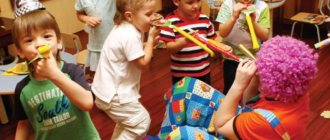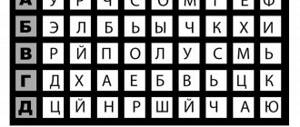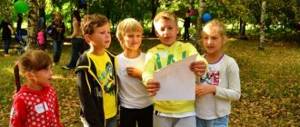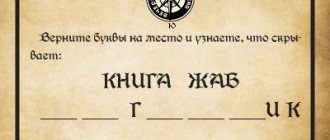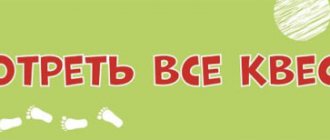My memories from childhood + imagination were enough for exactly one quest: a dozen tasks that are not duplicated. But the children liked the fun, they asked for more quests and had to go online. This article will not describe the script, legends, or design. But there will be 13 ciphers to encode the tasks for the quest.
Code number 1. Picture
A drawing or photo that directly indicates the place where the next clue is hidden, or a hint at it: broom + socket = vacuum cleaner Complication: make a puzzle by cutting the photo into several parts.
Code 2. Leapfrog.
Swap the letters in the word: SOFA = NIDAV
Cipher 3. Greek alphabet.
Encode the message using the letters of the Greek alphabet, and give the children the key:
Code 4. Vice versa.
Write the assignment backwards:
- every word: Etishchi dalk dop Jonsos
- or an entire sentence, or even a paragraph: here's the sea momas in - akzaksdop yaashchuudelS. itup monrev an yv
Code 5. Mirror.
(when I did the quest for my children, at the very beginning I gave them a “magic bag”: there was a key to the “Greek alphabet”, a mirror, “windows”, pens and sheets of paper, and all sorts of unnecessary things for confusion. Finding the next riddle , they had to figure out for themselves what from the bag would help them find the answer)
Code 6. Rebus.
The word is encoded in pictures:
Cipher 7. Next letter.
We write a word, replacing all the letters in it with the following ones in alphabetical order (then I is replaced by A, in a circle). Or the previous ones, or the next ones after 5 letters :).
CABINET = SHLBH
Code 8. Classics to the rescue.
I took a poem (and told the children which one) and a code of 2 numbers: line number number of letters in the line.
Example:
Pushkin "Winter Evening"
The storm covers the sky with darkness, spinning snow whirlwinds; Then she will howl like an animal, Then she will cry like a child, Then she will suddenly rustle with straw on the dilapidated roof, Then, like a belated traveler, she will knock on our window.
21 44 36 32 82 82 44 33 12 23 82 28
Did you read it, where is the hint? 
Code 9. Dungeon.
Write the letters in a 3x3 grid:
Then the word WINDOW is encrypted like this:
Code 10. Labyrinth.
My children liked this code; it is unlike the others, because it is not so much for the brain as for attention.
So:
On a long thread/rope you attach the letters in order, as they appear in the word. Then you stretch the rope, twist it and entangle it in every possible way between the supports (trees, legs, etc.). Having walked along the thread, as if through a maze, from the first letter to the last, the children will recognize the clue word.
Imagine if you wrap one of the adult guests in this way! Children are reading - The next clue is on Uncle Vasya. And they run to feel Uncle Vasya. Eh, if he is also afraid of tickles, then everyone will have fun!
Code 11. Invisible ink.
Use a wax candle to write the word. If you paint over the sheet with watercolors, you can read it. (there are other invisible inks... milk, lemon, something else... But I only had a candle in my house :))
Code 12. Rubbish.
The vowels remain unchanged, but the consonants change according to the key. for example: SHEEP SCHOMOSKO reads as - VERY COLD, if you know the key: L H N H Z M SCH K V
Code 13. Windows.
The kids loved it incredibly! They then used these windows to encrypt messages to each other all day long. So: on one sheet of paper we cut out windows, as many as there are letters in the word. This is a stencil, we apply it to a blank sheet of paper and write a clue word in the windows. Then we remove the stencil and write many different unnecessary letters on the remaining blank space of the sheet. You can read the code if you attach a stencil with windows. The children were at first stupefied when they found a sheet covered with letters. Then they twisted the stencil back and forth, but you still need to put it on the right side!
Code 14. Map, Billy!
Draw a map and mark (X) the location with the treasure.
When I did the quest for mine for the first time, I decided that the map was very simple for them, so I needed to make it more mysterious (then it turned out that just a map would be enough for the children to get confused and run in the opposite direction)... This is the diagram of our street. The clues here are house numbers (to help you understand that this is actually our street) and huskies. This dog lives with a neighbor across the street. The children did not immediately recognize the area and asked me leading questions. Then 14 children took part in the quest, so I united them into 3 teams. They had 3 versions of this map and each one had its place marked. As a result, each team found one word: “SHOW” “FAIRY TALE” “TURNIP” This was the next task :). He left behind some hilarious photos! For my son’s 9th birthday, I didn’t have time to invent a quest, so I bought it on the MasterFuns website.. At my own peril and risk, because the description there is not very good. But my children and I liked it because:
- inexpensive (similar to about 4 dollars per set)
- quickly (paid, downloaded, printed, everything took 15-20 minutes)
- There are a lot of tasks, with plenty to spare. And although I didn’t like all the riddles, there was plenty to choose from, and you could enter your own task
- everything is decorated in the same monster style and this gives the holiday effect. In addition to the quest tasks themselves, the kit includes: a postcard, flags, table decorations, and invitations to guests. And it's all about monsters!

- In addition to the 9-year-old birthday boy and his friends, I also have a 5-year-old daughter. The tasks were beyond her, but she and her friend also found entertainment - 2 games with monsters, which were also in the set. Phew, in the end - everyone is happy!
You have to organize a party for children
, or you want to please your child with an unexpected gift, or friends with children will come to visit you and you want to keep them busy with something interesting? Arranging a quest for children would be the best solution, because all children love adventures and searches. We will share where to start to make a quest for children at home, which can be adapted for a cafe, cottage, courtyard, etc.
Organizing a quest for children at home is a great solution, because all children love adventure and exploration. We will share where to start to create such a quest so that your children and their friends will discuss it for a long time and remember it as a bright event. In addition, such a quest can be easily carried out both at home and in a cafe, at the dacha, in the yard
etc.
5 secrets on how to prepare a quest without mistakes and surprises
A selection of the most popular themes for children's parties
3 lessons of magic from Harry Potter
Why most house quests end in failure
Top 10 best ciphers for children's quests
So, you decided to do the quest yourself. Use your imagination to the fullest and be patient!
Important: it is better to prepare the quest when the children are not at home, otherwise there will be no surprise.
First step
– determine the task of the quest (what awaits you in the final):
- solve the crime
- find the treasure
- save the princess from the terrible dragon
- save the birthday cake from being captured by monsters
- any plot of your favorite fairy tales/cartoons
Sometimes the desired ending can lead to a plot idea.
At the end you need a prize (treasure, cake, gift, desired toy or treat). It doesn't have to be something big and valuable. If this is just a fun quest for a child at home, then candy, a board game, a puzzle or a book would be a great option.
Step two
– choose how the child will move from clue to clue. Here are the possible options:
- We give the child a mysterious letter or part of a map that was found under the door / in the closet
- a child receives a message with a task on his mobile phone from an unknown recipient
- You transform into a wizard / witch / pirate / good fairy / favorite character and give the child tasks, for completing which he receives a hint where to go next or parts of the map / spell, collecting which he will find treasures.
It is very important to correctly determine the topic for the quest. If your child doesn't have a favorite character, here is a list of popular themes that children most often enjoy:
- Pirates (treasure hunt)
- Secret agents
- Superheroes (for boys)
- Fairies, princesses (for girls)
- Cowboys, Indians
- Wizards, mages, sorcerers
- Detectives
- Heroes of fairy tales (for preschool children, the plot of mixed up heroes who need to be returned back to their fairy tales is usually used)
- Dinosaurs
- Scientific developments (scientists, inventors)
Tasks can be like this:
- decipher messages and codes
- solve puzzles, puzzles, riddles;
- sing a song, portray joy/fear/show what true friends mean, remember some joyful moments in life, take photos with funny props (mustaches, glasses, hats, etc.)
- color the necessary letters and numbers
The easiest way to conduct a quest is to place small notes with hints in different rooms. In each note you need to guess the place where to look for the next clue, and at the end (after 9-12 tests) the children find a treasure (gift, key, cake, etc., depending on the plot).
Whatever plot option you choose, you need to start by identifying 7-9 places in the apartment where it would be fun and safe to find notes with clues. It can be anything: a book, a box, a box with toys, a washing machine, a freezer (you can freeze a fragment of a card), a balcony, a toy, a clue can be found under the carpet, under a chair, in a closet, etc. Do not use a vacuum cleaner, pots of soil, a rug in front of the front door, a laundry basket, or other potentially dirty objects that would be unpleasant for the player to look for clues in.
Also, do not hide clues on the outside of the window, behind bulky items that could fall on a child, or inside a switched-on electrical appliance.
It is important that the child does not find the clue ahead of time, for example, by going to wash his hands. And the treasures themselves need to be hidden so that it is impossible to find them at all without first collecting all the clues.
You have determined the places, now number them so that the child moves from point to point, each time changing the room or at a sufficient distance from each other.
For example, after he finds a clue in the piano in the living room, then he needs to go to the refrigerator in the kitchen or the flower pot in the bedroom, and after that to the hallway. If we find a clue in a chest of drawers or a box of toys, we run to the mailbox or key holder, and from there to the balcony.
If you're done with that, you have a plan ready. Now again there are two ways.
How to make a quest more interesting?
Add challenging tasks.
Ciphers. We could write a separate book about them, but today we’ll share the universal ones:
“Windows” code (quite complex, for children over 9 years old)
Write the letters in a 3x3 grid:
Then the word BATH is encrypted like this:
The letter is backwards.
Write the assignment backwards:
- every word:
- or an entire sentence, or even a paragraph:
Etishchi dalk extra Jonsos
Here's the sea momas in - akzaksdop yaashyuudelS. itup monrev an yv
Mirrored.
Symbol - letter
Instead of a letter - a number in the alphabet. For example, 2, 1, 13, 12, 16, 15 (Balcony)
Puzzle! Children most often love puzzles. This can be a picture printed on a printer, cut into 9-10 parts (it can be 3 or 30, depending on the age of the child), which shows the next place or on the back of which the following clue is written
Skipping vowels
You can write the text without vowels (a, o, u).
For example, I give the following sentence: “A clue awaits you in the darkest place.” The encrypted text will look like this: “Pdskzk is waiting for everything in smm Move five steps forward from the sofa, turn to the right and take three more big steps” turns into “About that child Napyatsha gov in front of the van on the back tesna right vois dela still tribo Lshi hsha ga.”
Not every adult will notice the catch. Children usually love it when gobbledygook magically turns into understandable text.
Morse code
Perfect for a quest about secret agents or detectives
In this alphabet, each letter of the alphabet has its own code, consisting of dots and dashes. So, A is “-”, I is “--”, etc.
You can cut the alphabet itself into several parts to make it even more complicated.
Caesar Cipher
This cipher is suitable for players aged 11 years and older and requires either your help or the fact that the children are familiar with some ciphers.
This cipher uses an alphabetical shift by a certain number of characters (usually 3, but 1 is possible).
For example, the phrase “You are already close, look under the bed” is encrypted like this (shift by 3 letters)
Eyu tsyz dolknl, llkhz tszh nuseghyab.
For convenience, there are many online calculators on the Internet that will encrypt any of your text.
Invisible ink: a home analogue of a UV pen can be inscriptions with milk or lemon juice, which appear when heated (candle, iron). We prefer messages with a strong soda solution; you can draw a hint with a wax crayon (or a paraffin candle) and put paint on it, the children will paint it over and the picture (or inscription) will appear.
Divide the word into syllables and put little notes in the pasta, or cut up cocktail tubes and stick the notes in there, even if some are empty. The kids will love it!
Use puzzles:
The word “box” is encrypted here
Include keys and locks in the game. Let the child find a key with each note and collect them, but only the last one will help him open the treasure chest.
Use phrases from books as clues: for example, the child found a code with the name of his favorite book and page, the line at the top and the words in it. The next place may be encrypted there, or maybe it will be a password phrase for passage to the land of dreams. For example, a child found a line from “The Little Prince” “Only the heart is vigilant”, said it and received a key.
Help your child, guide him, but don’t do it for him, don’t deprive him of the joy of victory!
Well, what if you chose the option of transforming into a pirate/fairy/Snow Maiden?
Think about what exactly your kid will collect in the end if he completes all the tasks of your character?
Card or spell, key or password?
Draw a map, no matter how you are with drawing, let it be simple. For ambiance, you can make it on craft paper and burn it on different sides.
Cut the finished map in such a way that none of the pieces, except the last one, give a ready answer where to look for treasure (like a puzzle)
It's a good idea to test your child to see if he is worthy of being called a pirate, star warrior, secret agent or princess. To prove this, the guys will undergo tests.
Any quest can be themed if your child is a fan of Harry Potter, Anna and Elsa or Star Wars.
Well, if you are ready to work harder to create a children's adventure, you can make a home labyrinth, hang bells (bells) and keep the children occupied for the whole evening
Imagine, try, give your child an adventure.
And if you want to entrust your holiday to professionals and give your child an unforgettable adventure
with experienced presenters, unusual props, interesting costumes and unusual scenarios, contact us, we will organize
a quest-style holiday
wherever you want.
Once upon a time, the eldest Nastya and I voraciously played detectives and detectives, came up with our own codes and methods of investigation. Then this hobby passed and now it has returned again. Nastya has a fiancé, Dimka, who enthusiastically plays scouts. My daughter shared his passion. As you know, in order to transmit important information to each other, intelligence officers need a code. With these games you will also learn how to encrypt a word or even an entire text!
White spots
Any text, even without a code, can turn into hard-to-read gibberish if the spaces between letters and words are incorrectly placed.
For example, this is what the simple and understandable sentence “Meet on the shore of the lake”
—
“Meeting Yanaber Yeguozera”
.
Even an attentive person will not immediately notice the catch. But experienced intelligence officer Dimka says that this is the simplest type of encryption.
No vowels
Or you can use this method - write the text without vowels.
For example, I give the following sentence: “The note lies in the hollow of an oak tree that stands at the edge of the forest.”
.
The encrypted text looks like this: “Zpska lies in dpl db, ktr stt n pshke ls
.
This will require ingenuity, perseverance, and, possibly, the help of adults (who also sometimes need to exercise their memory and remember their childhood).
Read it backwards
This encryption combines two methods at once. The text must be read from right to left (that is, vice versa), and spaces between words can be placed at random.
Here, read and decipher: “Neleta minv oak, manoro tsop irtoms”
.
Second for the first
Or each letter of the alphabet can be represented by the letter that follows it. That is, instead of “a” we write “b”, instead of “b” we write “c”, instead of “c” we write “d” and so on.
Based on this principle, you can create an unusual cipher. To avoid confusion, we made mini-cheat sheets for all participants in the game. It is much more convenient to use this method with them.
Guess what kind of phrase we have encrypted for you: “Tjilb g tjsibmzh fiobue mzhdlp - po ozhlpdeb ozh toynbzhu shmarf”
.
Deputies
The “Replacement” method is used on the same principle as the previous cipher. I read that it was used to encrypt sacred Jewish texts.
Instead of the first letter of the alphabet, we write the last, instead of the second, the penultimate one, and so on. That is, instead of A - Z, instead of B - Yu, instead of C - E...
To make it easier to decipher the text, you need to have the alphabet and a piece of paper with a pen on hand. Look at the letter matches and write it down. It will be difficult for a child to estimate by eye and decipher.
Tables
You can encrypt text by first writing it into a table. You just need to agree in advance which letter you will use to mark the spaces between words.
A small hint - it should be a common letter (such as p, k, l, o), because letters that are rarely found in words immediately catch the eye and because of this the text is easily deciphered. You also need to discuss how big the table will be and how you will enter the words (from left to right or from top to bottom).
Let's encrypt the phrase together using the table: At night we go to catch crucian carp.
We will denote a space with the letter “r”, writing words from top to bottom. Table 3 by 3 (we draw in the cells of a regular notebook sheet).
Here's what we get:
N B I M O T K A Y O Y D R V A S R CH R E L I R R E.
Lattice
In order to read the text encrypted in this way, you and your friend will need the same stencils: sheets of paper with squares cut out on them in random order.
The encryption must be written on a piece of paper in exactly the same format as the stencil. The letters are written in the hole cells (and you can also write, for example, from right to left or from top to bottom), the remaining cells are filled with any other letters.
The key is in the book
If in the previous code we prepared two stencils, now we will need identical books. I remember back in my childhood, boys at school used Dumas’ novel “The Three Musketeers” for these purposes.
The notes looked something like this: “324 s, 4 a, b, 7 syllables. 150 s, 1 a, n, 11 sl...”
First digit
indicated the page number,
the second
- the paragraph number,
the third letter
- how to count paragraphs from above (v) or from below (n),
the fourth letter
- the word.
In my example, you need to look for the necessary words: First word: on page 324, in the 4th paragraph from the top, the seventh word. Second word: on page 150, 1 paragraph from the bottom, eleventh word.
The decryption process is slow, but no outsider will be able to read the message.
Imagine the world around you, in which there is not a single secret, not a single unsolved riddle. How boring it would be! Who loves everything mysterious and secret more than anyone else in the world? Of course, children! Their inquisitive mind strives to explore the unknown, to find the key to all the secrets.
On the other hand, a child, like any other person, has his own secrets: how else could he feel like an individual and preserve his “I” in front of the people around him, including adults. Let's remember ourselves as children: when writing a note to a school friend, did we write it using 33 letters of the alphabet? Most likely not: a special secret alphabet served these purposes. Each group of friends had their own, but, one way or another, it helped keep secret what we didn’t want to tell everyone.
Almost everyone will like this game of “spy” and “detective”. How great it is to imagine yourself as agent 007 or a character in your favorite detective story! In addition, secret writing perfectly develops thinking: after all, converting some signs into others, incomprehensible, is only half the battle; you also need to be able to quickly read the encrypted messages of your comrades. And this is a real logical puzzle, no less! Its implementation requires concentration, attention and a good sense of rhythm from the young codebreaker.
Isn't that interesting? Please be patient and read this article to the end. In it you will find detailed tips on creating a secret cipher, as well as learn where it can be used, and get acquainted with a brief history of cryptography - the science of encryption.
Quest tasks for adult players
For example, the tasks for the outdoor quest for adult players in The Secret of the Vanished Tribe offer a standard level of difficulty.
However, the set contains tasks that can significantly increase it.
So, this task uses the Vigenère cipher.
Players can find the key to it in the archaeologist's notes that they have.
The key to the cipher is the word “Moscow”.
Having guessed this, players will be able to decipher “yuegshf” and find out that the game artifact is kept by the pine tree.
And in this clue from the quest “The Key”, which can be done at home or in the office, sympathetic ink is used.
Which can be revealed by H2O or water.
Those. The card needs to be wet to reveal the text.
Where there is a person, there is a secret, or Some interesting facts from the history of encryption
- Everyone has their own secrets, so it is fair to say: “Where there is a person, there is a secret.” Back in the 2nd millennium BC. in Ancient Egypt there was a writing system called enigma, and by the Greeks in the V-IV centuries. BC. One of the first encryption devices, “Skitala,” was invented. By the way, the Greeks came up with the idea of translating letters into numbers (if only they knew that in the future their idea would turn into the so-called “school cipher”, more about it below).
- In ancient India, secret writing was considered one of the 64 arts that women should master.
- The first book about encryption was published in Arabic in 855 and was called “The Book of Man’s Great Striving to Unravel the Mysteries of Ancient Writing.”
- In Rus' from the XII-XIII centuries. Litorrhea was used - a special alphabetic code, when the vowels in words remained in place, and the consonants changed places.
- Both children and adults are familiar with Arthur Conan Doyle's detective story "The Dancing Men." But few people know that humanoid icons were invented back in the 8th century. Emperor Charlemagne.
- But the writer (and part-time mathematician) Lewis Carroll invented his own method of encryption, and in very unusual circumstances. One cold winter evening (as always), many brilliant thoughts were spinning in his head. But I didn’t want to get out from under the warm blanket to light a candle, so Carroll came up with a nycgraph
- a special stencil with which you can write in the dark!
What can be encoded?
You can encode any information presented in various formats.
We recommend the course “Neuroteacher” to all proactive teachers. How to apply modern knowledge about the brain in the classroom?”
I will list specifically:
- link to additional text information on the topic;
- link to video fragment;
- decoding the answer to the question;
- link to audio recording;
- link to the online quiz;
- link to the interactive task;
- link to a joint presentation or online whiteboard.
What is a secret code? Instructions for a young detective.
1. Replacing some characters with others
There are a great many such ciphers. There are even entire cryptographic “libraries” on the World Wide Web, where all these codes are collected, decrypted and conveniently formatted. You can change some letters for others, letters for numbers, real signs for fictitious ones.
A striking example is the above-mentioned “school cipher” - probably the simplest and fastest method of encryption. Its principle is to remember the numbers of letters in the alphabet and replace the letters with numbers, separated by commas. For example, the word "mom" would look like "14, 1, 14, 1." For greater secrecy, the numbers can be shifted - for example, with an interval of +3: the letter A will turn into 4, and M into 17.
An analogue of the “school cipher” can be created by typing on an ordinary computer keyboard: simply replace the Russian letters with the corresponding Latin characters. By the way, this will help improve your typing skills.
This also includes “dancing men” and L. Carroll’s nycgraphy. Come up with your own original code: you can do this not only with your friends and peers, but also with your whole family, and then find encrypted notes in the kitchen in the morning. Great exercise for the mind!
Examples:
alarm clock - 4, 23, 7, 12, 15, 32, 17, 12, 14 (key - letter number +2) candy - rjyatnf ("keyboard" cipher) store - nizgagam, toy - akshgrui, shoe - kontiob (try to guess the key to this cipher yourself!)
2. Half-word
This encryption method was used back in Ancient Rus' to classify secret messages and documents. The half-word signs vaguely resemble real letters, but unfinished. You can do the opposite - add new elements to well-known letters so that they change almost beyond recognition.
3. Inserting extra sounds
In every class there are such “polyglots” who periodically start talking to each other in an incomprehensible language. You listen and listen – and you can’t make out whether it’s English, German or some kind of gibberish! The last assumption is closest to the truth. So-called “gibberish” consists of words in your native language with extra sounds inserted after each syllable. Let’s say we want to pronounce the word “school” so that only our narrow group of friends understands it. There is nothing simpler: we add some syllable to it, for example, “ro”, and instead of “school” we get the mysterious “shkorolaro”. And if you insert “ro” before the syllables, no one will hear the famous word!
By the way, if the previous encryption method is suitable exclusively for written negotiations, then this one is simply ideal for oral ones.
Examples:
gift - pokudakurokku bookmark - zamekladmekame university - uzonizoverzosizotetzo
4. The letter is backwards.
Everything here is extremely simple and clear: we write all the words backwards. Or maybe someone will be able to speak such an encrypted language! In any case, the logic will become simply ironclad.
Examples:
backpack - kazkyur steam locomotive - zovorup computer - retyupmok information - yynnoitsamrofni electricity - yaigreneortkele
5. Creative cryptography.
Who said that letters and words need to be replaced with similar squiggles? After all, a secret alphabet can be created from alternative symbols. There is a 3D pipeline alphabet, where the letters are differently curved pipes. And experimenter John Regsdale recently, in 2006, came up with the Puzzle Code, where the parts of the message are parts of a complex puzzle. If you are good with imagination (and this is probably the case), come up with your own unique code and tell everyone about it!
Steganography
Steganography is older than coding and encryption. This art appeared a long time ago. It literally means “hidden writing” or “secret writing.” Although steganography does not exactly correspond to the definition of a code or cipher, it is intended to hide information from prying eyes.
Steganography is the simplest cipher. Typical examples are swallowed notes covered with wax, or a message on a shaved head that is hidden under the growth of hair. The clearest example of steganography is the method described in many English (and not only) detective books, when messages are transmitted through a newspaper where letters are discreetly marked.
The main disadvantage of steganography is that an attentive outsider can notice it. Therefore, to prevent the secret message from being easily read, encryption and encoding methods are used in conjunction with steganography.
"Enigma"
Everyone knows that Enigma was the main Nazi encryption machine during World War II. The Enigma structure includes a combination of electrical and mechanical circuits. How the cipher turns out depends on the initial configuration of the Enigma. At the same time, Enigma automatically changes its configuration during operation, encrypting one message in several ways throughout its entire length.
In contrast to the simplest ciphers, Enigma gave trillions of possible combinations, which made breaking encrypted information almost impossible. In turn, the Nazis had a specific combination prepared for each day, which they used on a specific day to transmit messages. Therefore, even if Enigma fell into the hands of the enemy, it did not contribute in any way to deciphering messages without entering the necessary configuration every day.
They actively tried to crack Enigma throughout Hitler's military campaign. In England in 1936, one of the first computing devices (Turing machine) was built for this purpose, which became the prototype of computers in the future. His task was to simulate the operation of several dozen Enigmas simultaneously and run intercepted Nazi messages through them. But even the Turing machine was only occasionally able to crack a message.
Morse code
The alphabet is a means of exchanging information and its main task is to make messages simpler and more understandable for transmission. Although this is contrary to what encryption is intended for. Nevertheless, it works like the simplest ciphers. In the Morse system, each letter, number and punctuation mark has its own code, made up of a group of dashes and dots. When transmitting a message using the telegraph, dashes and dots represent long and short signals.
Telegraph and Morse code... Morse was the one who first patented “his” invention in 1840, although similar devices had been invented before him in both Russia and England. But who cares now... The telegraph and Morse code had a very great influence on the world, allowing messages to be transmitted almost instantly over continental distances.
ADFGX encryption algorithm
This is the most famous World War I cipher used by the Germans. The cipher got its name because the encryption algorithm led all ciphergrams to alternate these letters. The choice of the letters themselves was determined by their convenience when transmitted over telegraph lines. Each letter in the cipher is represented by two. Let's look at a more interesting version of the ADFGX square that includes numbers and is called ADFGVX.
| A | D | F | G | V | X | |
| A | J | Q | A | 5 | H | D |
| D | 2 | E | R | V | 9 | Z |
| F | 8 | Y | I | N | K | V |
| G | U | P | B | F | 6 | O |
| V | 4 | G | X | S | 3 | T |
| X | W | L | Q | 7 | C | 0 |
The algorithm for composing the ADFGX square is as follows:
- We take random n letters to denote columns and rows.
- We build an N x N matrix.
- We enter into the matrix the alphabet, numbers, signs, randomly scattered across the cells.
Let's make a similar square for the Russian language. For example, let's create a square ABCD:
| A | B | IN | G | D | |
| A | HER | N | b/b | A | I/Y |
| B | H | V/F | H/C | Z | D |
| IN | Sh/Shch | B | L | X | I |
| G | R | M | ABOUT | YU | P |
| D | AND | T | C | Y | U |
This matrix looks strange, since a number of cells contain two letters. This is acceptable; the meaning of the message is not lost. It can be easily restored. Let's encrypt the phrase “Compact Cipher” using this table:
| 1 | 2 | 3 | 4 | 5 | 6 | 7 | 8 | 9 | 10 | 11 | 12 | 13 | 14 | |
| Phrase | TO | ABOUT | M | P | A | TO | T | N | Y | Y | Sh | AND | F | R |
| Cipher | bv | guards | GB | gd | ah | bv | db | ab | dg | hell | va | hell | bb | ha |
Thus, the final encrypted message looks like this: “bvgvgbgdagbvdbabdgvdvaadbbga.” Of course, the Germans ran a similar line through several more ciphers. And the result was a very hack-resistant encrypted message.
Codes
Real codes consist of correspondences for each word of a separate code. To work with them, you need so-called code books. In fact, this is the same dictionary, only containing translations of words into codes. A typical and simplified example of codes is the ASCII table - the international cipher of simple characters.
The main advantage of codes is that they are very difficult to decipher. Frequency analysis almost doesn't work when hacking them. The weakness of the codes is, in fact, the books themselves. Firstly, their preparation is a complex and expensive process. Secondly, for enemies they turn into a desired object, and intercepting even part of the book forces them to change all the codes completely.
In the 20th century, many states used codes to transmit secret data, changing the code book after a certain period. And they actively hunted for the books of their neighbors and opponents.
